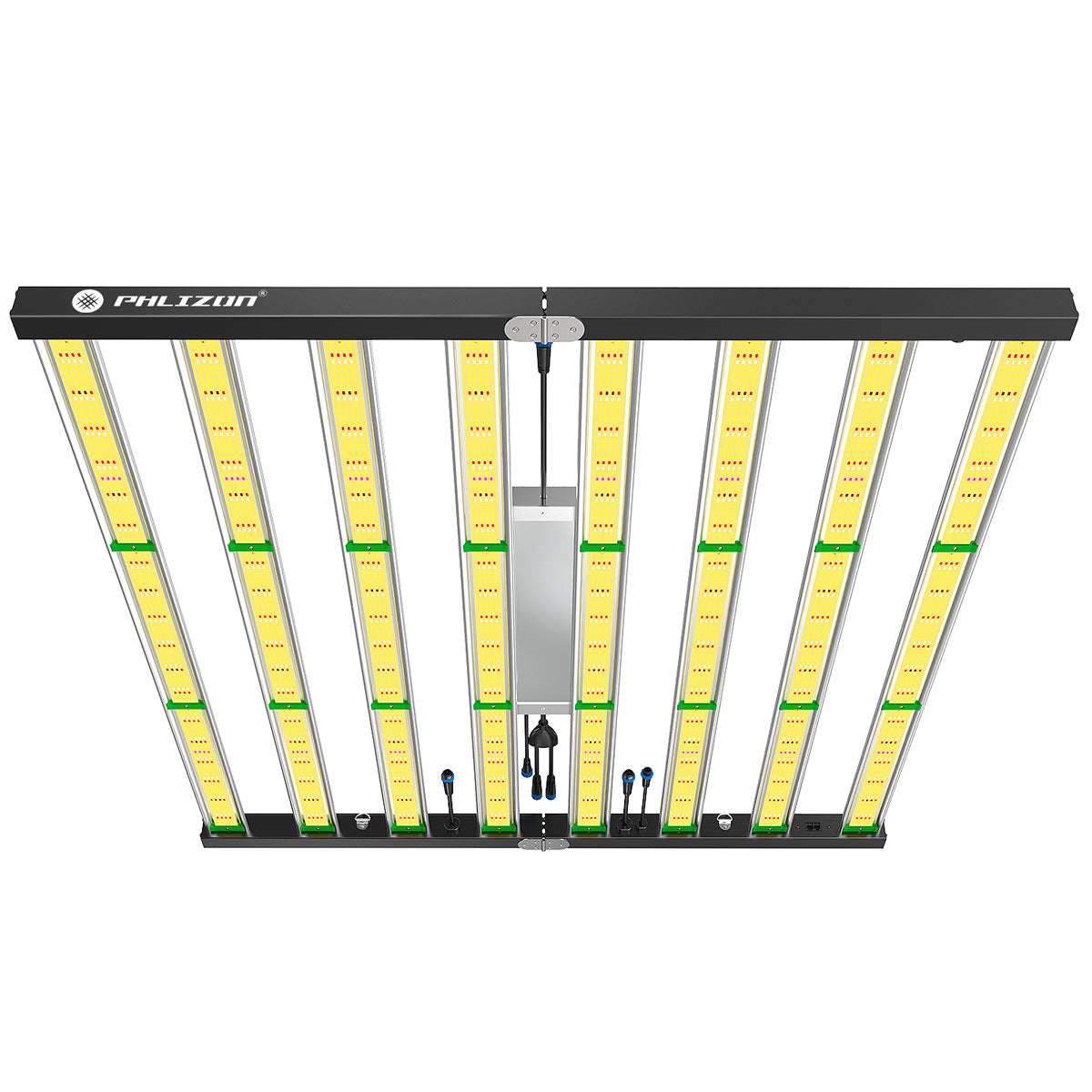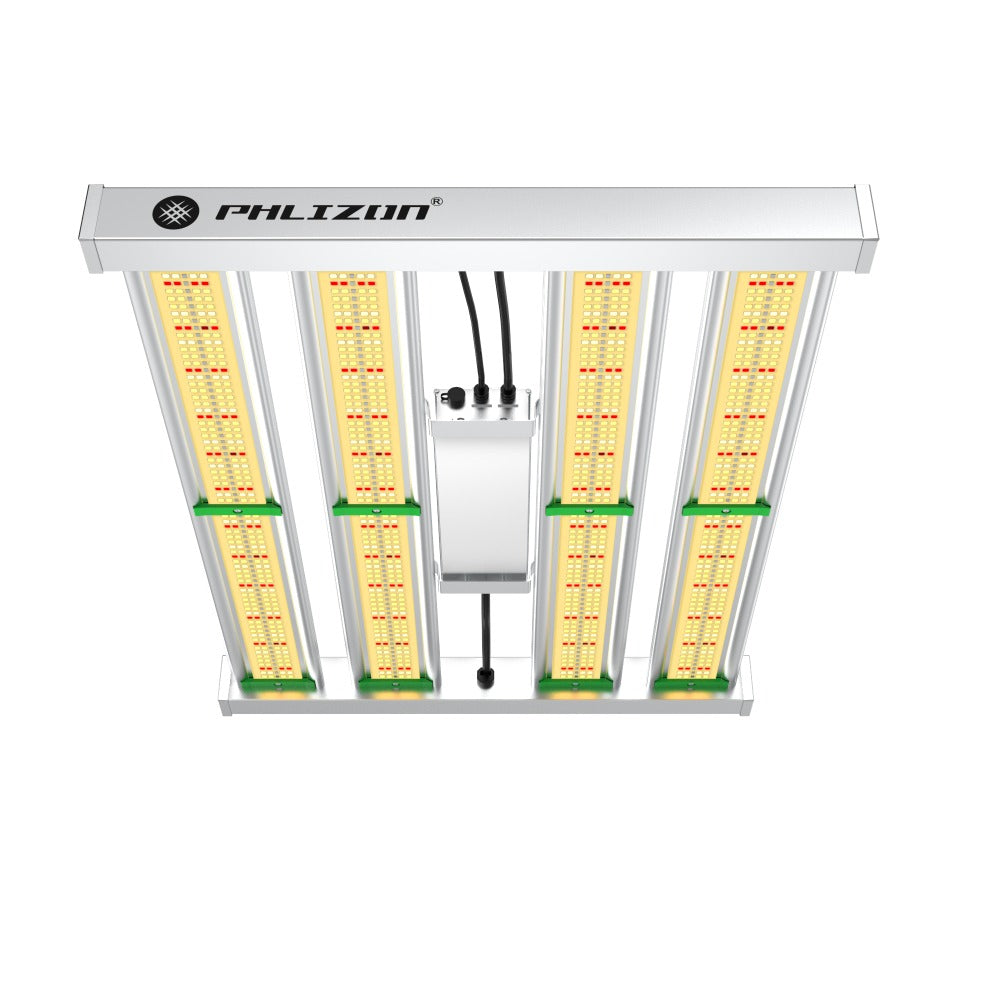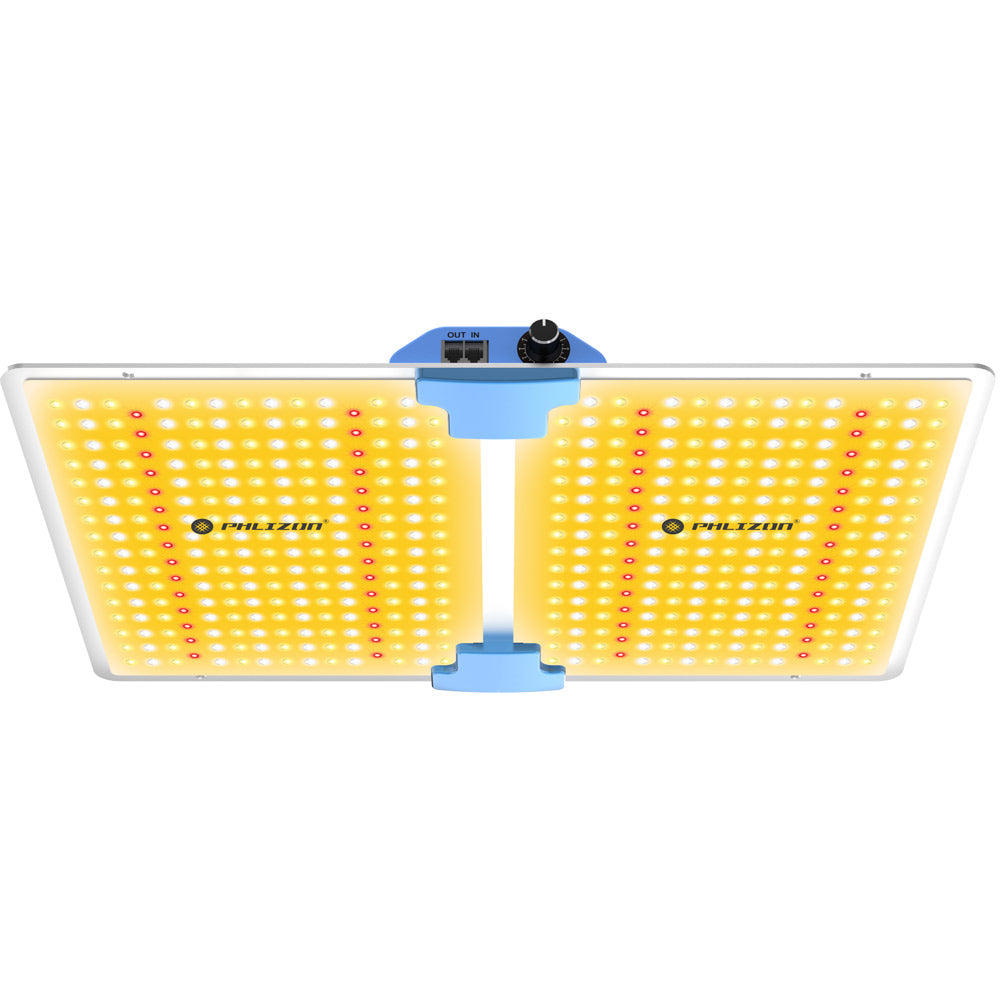Menu
Are All LED Lights Grow Lights?
The question of whether all LED lights can serve as grow lights is a common one among indoor gardeners and plant enthusiasts. To address this, we’ll dive into the specifics of what plants need from light, how LED technology works, and why not every LED light is suitable for growing plants.
Grow Light vs Regular Light: Can Any LED Light Grow Plants?
The answer is no—not all LED lights can function as grow lights. Plants require specific wavelengths of light for photosynthesis, primarily blue light (400–500 nm) and red light (600–700 nm). Through evolution, plants have adapted to efficiently utilize the full spectrum of sunlight for growth. LED grow lights are specifically designed to mimic the sun's spectrum, whereas regular LED lights typically lack these essential wavelengths and are only suitable for general illumination. While LED lights may support plant growth to some extent, specialized LED grow lights deliver better results by providing the precise light spectrum and intensity required for plant development.
Blue and red wavelengths are critical for plant growth, with each playing a unique role. Blue light encourages leafy development, while red light supports flowering. In the seedling and vegetative stages, plants benefit from more blue light to promote root and leaf growth. As plants transition to the flowering stage, they require increased red light to stimulate blooming. A study found that plants exposed to a combination of red and blue light developed thicker leaves and had higher photosynthetic efficiency compared to those grown under standard white LEDs. Besides, many LED grow lights offer adjustable full-spectrum light to cater to these different stages of growth, allowing growers to fine-tune the light spectrum for optimal plant development and maximize yields throughout the growth cycle.
There are significant differences between regular LED lights and grow LED lights in terms of spectrum, light intensity, and efficiency. While regular LED lights can help plants grow, it’s important to use grow lights with a specially designed spectrum and intensity that is intended to support plant growth. For plants to thrive, they need full-spectrum LED lights that mimic natural sunlight, providing the right balance of blue and red wavelengths crucial for various growth stages.
Can You Grow Plants With an LED Light?
If you don’t have a ton of natural light in your home, you might start eyeing your LED lights to use as grow lights. Plants, even low-light plants, need light to grow, and artificial lights are an excellent way to ensure they’re getting what they need. But can you just use a regular LED light as a grow light, or does it have to be an LED grow light? Generally, specially designed grow lights are best to make your plants thrive, for reasons that will be explained below. However, grow lights are more expensive. If you have strong LED lights such as workshop lights that emit light with a similar light spectrum and intensity as grow lights, you might be able to use those.
If you already have other full-spectrum LED lights in your home, they can serve as a viable alternative. Here are a few tips for when and how to use grow lights for your indoor plants: When placing a plant in a location with insufficient natural light, use a grow light from the beginning. Bringing a sickly, light-deprived plant back to health later is usually more difficult. Always match the grow light to the plant’s light requirements. Seedlings, young plants, and plants grown for their foliage need less light than flowering plants. Don’t place the light too close to your plant. Many grow lights have adjustable heights so as the plants grow, you are able to change the distance. Set the timer of the grow lights according to the light conditions and the type of plants you are growing. If the plant is not getting any natural light, set the time for 8 to 16 hours to mimic the amount of natural sunlight.
LED grow lights mimic the role the sun has in photosynthesis. Full-spectrum LED grow lights emit a unique spectrum across all colors including red, green, and blue to help plants accelerate in all growth stages,Every type of light has a different role in plant growth. Blue light encourages vegetative leaf growth. The combination of blue and red light helps with flowering. Green light, although it is the least efficiently used color of light in the visible light spectrum, still plays a role in photosynthesis; it helps with leaf growth on lower parts of the plant because it penetrates the canopy better. Special growth lights also have a higher wattage than regular LED lights and they use that wattage to produce lights in the spectrum that is the most conducive to plant growth, which is not the white and yellow light used by standard lights for lighting purposes.
What Is the Difference Between LED Lights and LED Grow Lights?
LED lights and LED grow lights both use the same technology, but their applications differ. LED lights are often used as a replacement for incandescent bulbs in homes or businesses to provide general lighting. LED grow lights, on the other hand, use specific light options that are designed to encourage the photosynthesis of plants. The main difference between these two types of lights is the light intensity, spectrum, and color temperature. Regular LED lighting typically has lower brightness levels than what would be required for optimal plant growth. In addition, regular LEDs offer limited control over the type of light output needed for healthy plant development. Grow lights can provide more intense illumination with adjustable settings that allow you to fine-tune your desired level of light for optimum results when growing plants indoors.
The special light produced by grow lamps enables plants to absorb necessary nutrients which helps promote healthy growth and flowering cycles within an indoor environment. This creates a perfect balance for successful indoor gardening all year round without having to rely on natural sunlight alone. Standard LED bulbs typically emit more light with a broader range of colors in comparison to standard incandescent or fluorescent lights. While general-purpose LED lighting will give off white-light illumination, grow lights will produce greater amounts of red and blue spectrums which are ideal for stimulating photosynthesis in plants. Furthermore, when it comes to power efficiency, grow lights tend to consume less energy than traditional lighting solutions like fluorescent tubes or high-intensity discharge lamps usually found in commercial settings.
In comparison to regular LEDs, using LED grow lights provides far greater energy efficiency while still giving your plants all the nutrients required for them to thrive. With careful consideration over wattage output, beam angle, and coverage area, you will be able to get the most out of your LED grow light setup with minimal power usage. While regular LED lights may provide adequate light for some growth stages, LED grow lights are specifically designed to help nurture the growth process. Plants need both natural sunlight and artificial light to survive and thrive. For example, fluorescent bulbs emit blue wavelengths which can be beneficial in promoting healthy plant growth. However, when it comes to providing a more comprehensive spectrum of light that is tailored toward different stages of plant development, a LED grow light system is a better solution than regular LED lights.
How Do LED Grow Lights Work?
Energy-efficient LED grow lights are the lighting of the future of agriculture. They are not only economical in their use, but they produce better plants as well, in comparison to all traditional lighting options. LEDs (Light Emitting Diode) are small electronic components made of two different types of semiconductor material, one having a negative charge, called electrons, and the other having a positive charge, called holes. When voltage is properly applied over an LED, electric current starts to flow through it making electrons and holes start to collide releasing energy in the form of photons, light quanta, in a process called recombination.
There are several LED grow light benefits that make them a more viable choice over traditional grow lights. Color variations of the LED grow lights are directly connected to the intended purpose – various studies have shown that certain colors influence plant growth, affecting root and flower formation (blue and red light spectra) which practically means that the majority of plant sorts will complete a normal growth cycle if exposed to both blue and red grow lights. Adding other colors to the spectrum, such as green, far-red, and deep-blue aids this process by giving plants more information about its environment and overall resulting in higher quality plants (quicker growth, more secondary metabolite accumulation etc). A spectrum that contains all colors is called full spectrum and mostly resembles the sunlight. If it has high proportions of green, the light will appear white to human eyes and while not a crucial factor for plant growth, it does make the work around these lights easier and makes visual inspection of the plants possible.
LED Grow Lights vs. Regular LED Lights: A Deeper Look
Yes, you can use LED lights to grow plants, but not all LED lights are suitable for this purpose. You need a full-spectrum LED light that closely mimics natural sunlight. LED grow lights and standard LED lights both produce light, but they differ in the breadth and intensity of the spectrum they emit. LED grow lights generate a broader spectrum, usually within the 400-700nm range, encompassing blue (400-500 nm), green (500-600 nm), and red (600-700 nm) light. Each growth light spectrum positively influences plants: Blue light enhances foliage thickness and plant compactness. Green light aids in effective light absorption for lower-placed leaves. Red light influences plants to grow longer and narrower. In contrast, regular LEDs predominantly produce white and yellow light. Though they benefit plants to some extent, they aren’t as efficient as grow lights which are crafted explicitly for plant growth.
The strength of light emitted is a vital differentiation. Measured in PPFD (Photosynthetic Photon Flux Density), it quantifies the photosynthetic light that plants receive. While regular LED bulbs might seem bright, their PPFD is often lower than grow lights. For example, tests showed that standard LEDs ranged from 25 to 600 µMol/m^2/S based on distance, while grow lights could reach up to 1400 µMol/m^2/S. Hence, for indoor plant cultivation, grow lights are superior due to their adjustable light intensity. LED grow lights, despite their powerful output, are notably efficient in their heat emission. They are designed to produce the necessary light spectrum for plants with minimal heat waste. This is in stark contrast to older types of grow lights, such as HPS grow lights, which can generate substantial heat. Regular LED lights for household use also emit minimal heat, but they are not designed to be on for extended periods, unlike the grow lights.
FAQ: Common Questions About LED Lights and Grow Lights
Q: Can I use a regular LED bulb to grow plants indoors?
A: Yes, you can, but it’s not ideal. Regular LED bulbs usually emit white or yellow light, which lacks the full spectrum of wavelengths plants need for optimal growth. They might keep low-light plants alive, but for thriving growth, especially for flowering or fruiting plants, a specialized LED grow light is much better.
Q: What makes LED grow lights different from regular LEDs?
A: LED grow lights are engineered with a specific light spectrum—rich in blue and red wavelengths—that supports photosynthesis and plant development. Regular LEDs are designed for human visibility, focusing on white light, and don’t provide the intensity or range of wavelengths plants require.
Q: Do all LED grow lights need to be full-spectrum?
A: Not necessarily. Some grow lights focus on specific wavelengths, like blue for vegetative growth or red for flowering. However, full-spectrum LED grow lights are the most versatile, mimicking sunlight and supporting all growth stages, making them a popular choice for most growers.
Q: Will regular LED lights harm my plants?
A: No, they won’t harm your plants, but they won’t help them thrive either. The lack of sufficient blue and red light can lead to weak, leggy growth. If you’re serious about indoor gardening, investing in a grow light is worth it.
Q: How long should I leave LED grow lights on for my plants?
A: It depends on the plant type. Most vegetables and foliage plants do well with 12-14 hours of light daily, while flowering plants may need 14-16 hours. Always give plants at least 8 hours of darkness to allow respiration, which is crucial for their growth cycle.
Q: Are LED grow lights worth the extra cost compared to regular LEDs?
A: For serious plant growth, yes. They’re more energy-efficient, last longer (up to 50,000 hours or more), and provide the right light for healthy plants. Regular LEDs might save money upfront, but they won’t deliver the same results.
Final Thoughts
Not all LED lights are grow lights. While regular LEDs can offer some illumination for plants, they fall short of providing the specific wavelengths and intensity that plants need to photosynthesize effectively and grow strong. LED grow lights, with their tailored spectra and higher efficiency, stand out as the superior choice for indoor gardening. Whether you’re nurturing seedlings or coaxing flowers to bloom, understanding the distinction between these two types of lights can make all the difference in your plant’s success.
Featured blog
- Choosing a selection results in a full page refresh.

















